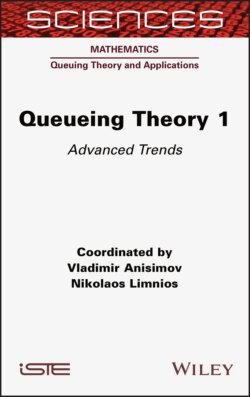Queueing Theory 1

Реклама. ООО «ЛитРес», ИНН: 7719571260.
Оглавление
Nikolaos Limnios. Queueing Theory 1
Table of Contents
List of Illustrations
List of Tables
Guide
Pages
Queueing Theory 1. Advanced Trends
Preface
1. Discrete Time Single-server Queues with Interdependent Interarrival and Service Times
1.1. Introduction
1.2. The Geo/Geo/1 case
1.2.1. Arrival probability as a function of service completion probability
1.2.1.1. Considerx0(b)
1.2.1.2. Consider E(X(b))
1.2.1.3. Special cases
1.2.2. Service times dependent on interarrival times
1.3. The PH/PH/1 case
1.3.1. A review of discrete PH distribution
1.3.2. The PH/PH/1 system
1.4. The model with multiple interarrival time distributions
1.4.1. Preliminaries
1.4.2. A queueing model with interarrival times dependent on service times
1.5. Interdependent interarrival and service times
1.5.1. A discrete time queueing model with bivariate geometric distribution
1.5.2. Matrix equivalent model
1.6. Conclusion
1.7. Acknowledgements
1.8. References
2. Busy Period, Congestion Analysis and Loss Probability in Fluid Queues
2.1. Introduction
2.2. Modeling a link under congestion and buffer fluctuations
2.2.1. Model description
2.2.2. Peaks and valleys
2.2.3. Minimum valley height in a busy period
2.2.4. Maximum peak level in a busy period
2.2.5. Maximum peak under a fixed fluid level
2.3. Fluid queue with finite buffer
2.3.1. Congestion metrics
2.3.2. Minimum valley height in a busy period
2.3.3. Reduction of the state space
2.3.4. Distributions of τ1(x) and V1(x) 2.3.4.1. Matrix differential equation
2.3.4.2. Distributions of the random variables
2.3.5. Sequences of idle and busy periods
2.3.6. Joint distributions of loss periods and loss volumes
2.3.7. Total duration of losses and volume of information lost
2.3.7.1. Absorbing Markovian arrival process
2.3.7.2. Distribution of τ(x)and V(x)
2.3.7.3. Loss probability
2.4. Conclusion
2.5. References
3. Diffusion Approximation of Queueing Systems and Networks
3.1. Introduction
3.2. Markov queueing processes
3.3. Average and diffusion approximation. 3.3.1. Average scheme
3.3.2. Diffusion approximation scheme
3.3.3. Stationary distribution
3.4. Markov queueing systems
3.4.1. Collective limit theorem in R1
3.4.2. Systems of M/M type
3.4.3. Repairman problem
3.5. Markov queueing networks. 3.5.1. Collective limit theorems in RN
3.5.2. Markov queueing networks
3.5.3. Superposition of Markov processes
3.6. Semi–Markov queueing systems
3.7. Acknowledgements
3.8. References
4. First-come First-served Retrial Queueing System by Laszlo Lakatos and its Modifications
4.1. Introduction
4.2. A contribution by Laszlo Lakatos and his disciples
4.3. A contribution by E.V. Koba
4.4. An Erlangian and hyper-Erlangian approximation for a Laszlo Lakatos-type queueing system
4.5. Two models with a combined queueing discipline
4.6. References
5. Parameter Mixing in Infinite-server Queues
5.1. Introduction
5.2. The MΛ/Coxn/∞ queue
5.2.1. The differential equation
5.2.2. Calculating moments
5.2.3. Steady state
5.2.4. MΛ/M/∞
5.3. Mixing in Markov-modulated infinite-server queues
5.3.1. The differential equation
5.3.2. Calculating moments
5.4. Discussion and future work
5.5. References
6. Application of Fast Simulation Methods of Queueing Theory for Solving Some High-dimension Combinatorial Problems
6.1. Introduction
6.2. Upper and lower bounds for the number of some k-dimensional subspaces of a given weight over a finite field
6.2.1. A general fast simulation algorithm
6.2.2. An auxiliary algorithm
6.2.3. Exact analytical formulae for the cases k = 1 and k = 2
6.2.4. The upper and lower bounds for the probability P{Yω ()}
6.2.5. Numerical results
6.3. Evaluation of the number of “good” permutations by fast simulation on the SCIT-4 multiprocessor computer complex
6.3.1. Modified fast simulation method
6.3.2. Numerical results
6.4. References
7. Diffusion and Gaussian Limits for Multichannel Queueing Networks
7.1. Introduction
7.2. Model description and notation
7.3. Local approach to prove limit theorems
7.3.1. Network of the [GI|M|∞]r-type in heavy traffic
7.4. Limit theorems for networks with controlled input flow. 7.4.1. Diffusion approximation of [SM|M|∞]r-networks
7.4.2. Asymptotics of stationary distribution for [SM|GI|∞]r-networks
7.4.3. Convergence to Ornstein–Uhlenbeck process
7.5. Gaussian approximation of networks with input flow of general structure. 7.5.1. Gaussian approximation of [G|M|∞]r-networks
7.5.2. Criterion of Markovian behavior for r-dimensional Gaussian processes
7.5.3. Non-Markov Gaussian approximation of -networks
7.6. Limit processes for network with time-dependent input flow. 7.6.1. Gaussian approximation of -networks in heavy traffic
7.6.2. Limit process in case of asymptotically large initial load
7.7. Conclusion
7.8. Acknowledgements
7.9. References
8. Recent Results in Finite-source Retrial Queues with Collisions
8.1. Introduction
8.2. Model description and notations
8.3. Systems with a reliable server. 8.3.1. M/M/1 systems. 8.3.1.1. Algorithmic approach
8.3.1.2. Asymptotic approach
8.3.2. M/GI/1 system
8.3.2.1. Algorithmic approach
8.3.2.2. Stochastic simulation
8.3.2.3. Asymptotic approach
8.4. Systems with an unreliable server
8.4.1. M/M/1 system. 8.4.1.1. Tool-supported approach by MOSEL
8.4.1.2. Algorithmic approach
8.4.1.3. Stochastic simulation
8.4.1.4. Asymptotic approach
8.4.2. M/GI/1 system. 8.4.2.1. Stochastic simulation
8.4.2.2. Asymptotic approach
8.4.3. Stochastic simulation of special systems
8.4.3.1. Gamma distributed interarrival times
8.4.4. Gamma distributed retrial times
8.4.5. The effect of breakdowns disciplines
8.4.5.1. Scenario A, gamma distributed service time
8.4.5.2. Scenario B, gamma distributed interarrival time
8.5. Conclusion
8.6. Acknowledgments
8.7. References
9. Strong Stability of Queueing Systems and Networks: a Survey and Perspectives
9.1. Introduction
9.2. Preliminary and notations
9.3. Strong stability of queueing systems
9.3.1. M/M/1 queue
9.3.1.1. Perturbation of the interarrival time distribution
9.3.1.2. Perturbation of the service time distribution
9.3.2. PH/M/1 and M/PH/1 queues
9.3.3. G/M/1 and M/G/1 queues
9.3.3.1. Strong stability in the G/M/1 queueing system
9.3.3.2. Strong stability of the M/G/1 queue
9.3.4. Other queues
9.3.5. Queueing networks
9.3.5.1. Jackson networks with two tandem stations
9.3.5.2. Tandem queues with constant retrials
9.3.5.3. Tandem queues with non-preemptive priority
9.3.5.4. Tandem queues with blocking
9.3.6. Non-parametric perturbation
9.4. Conclusion and further directions
9.5. References
10. Time-varying Queues: a Two-time-scale Approach
10.1. Introduction
10.2. Time-varying queues
10.3. Main results
10.3.1. Large deviations of two-time-scale queues
10.3.2. Computation ofH (y, t)
10.3.3. Applications to queueing systems
10.4. Concluding remarks
10.5. References
List of Authors
Index. A, B
C, D
E, F, G
H, I, J
E, F, G
Q, R
S, U, R
WILEY END USER LICENSE AGREEMENT
Отрывок из книги
Mathematics, Field Director – Nikolaos Limnios
.....
In applying K-R operator, here the first vector ψ is partitioned into K, 1 × 1 vectors, i.e. into scalars in order to properly apply the K-R operator.
This is better illustrated with an example.
.....